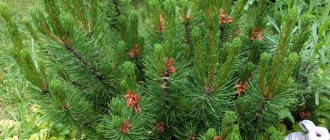Low-growing spherical chrysanthemums are a relatively young group of highly decorative flower plants. However, despite their insignificant age, the flowers quickly won the love of not only amateur flower growers, but also professional landscape designers. This popularity is explained by a number of positive qualities and advantages of a long-term culture: the spectacular appearance of a flowering low-growing “ball” that does not require pruning, a rich palette of colors of inflorescences, abundant long-term flowering, ease of care, accessible methods of propagation. Everything about planting and caring for low-growing spherical chrysanthemums is in this collection of material.
Varieties and varieties
Globular chrysanthemums vary in stem height. They are usually divided into:
- Short or dwarf - from 18 to 35 centimeters.
- Medium-sized - from 35 to 55 centimeters, for example, Knopa.
- Tall - from 55 to 70 centimeters, these include the Ida variety.
Medium-sized varieties are considered the most widespread. They look great in various garden arrangements and grow well in open ground. Low-growing ones are used to decorate flower beds and are planted in pots on loggias and balconies. The tallest species are most often chosen for planting in the back row of alpine slides or flower beds.
Globular chrysanthemums are also distinguished by their flowering period:
- Early flowering - flowering period occurs in August.
- Medium flowering - delight with bright colors in September.
- Late-blooming - the inflorescences of these varieties bloom in mid-autumn.
The most common variety is Multiflora. It belongs to the medium-growing and medium-flowering species and has a rich color palette.
Chrysanthemum photo
If desired, you can select types of chrysanthemums for planting in the garden so that they will decorate the area from late summer until the first frost.
Globular chrysanthemums combine well in flower beds with many other flowers and look impressive when planted alone. Tall varieties combine better with neighbors that achieve similar shoot growth or with coniferous trees. Low-growing flowers in open ground are used to frame borders or beds, to create boundaries of certain areas of the garden.
The range of different shades of color includes about 3,500 options. Against the background of lawn grass, white or yellow inflorescences are the most advantageous.
Description
I like chrysanthemum because it is easy to care for and yet has an attractive appearance. This is how she gained her popularity among flower growers. On one bush the number of flowers can reach up to 100 pieces. They have a wide variety of colors. They are ideal for making autumn bouquets.
The characteristics of chrysanthemums will be incomplete if we do not talk about their differences in the height of the bushes.
The height of these plants can range from 30 cm to 1.2 m, depending on the variety. Both tall and low-growing varieties grow on my site. The latter are good for planting in the foreground of an alpine hill, as well as for planting along the edge of a flower bed. Korean varieties of chrysanthemums, which do not exceed 30-40 cm, are excellent for this.
Perennial varieties are characterized by abundant and long flowering. In addition, they have a pleasant, delicate aroma, and bright colors decorate the area until late autumn.
I usually plant the following varieties of low-growing chrysanthemums:
- Mascot. It attracts all the attention, as it blooms with rich crimson flowers, giving a festive look to the area.
- Evening lights. They resemble the scarlet flash of fireworks and delight even those who prefer other colors.
- Varvara. The calm, purple inflorescences have a soft lilac hue.
Chrysanthemums love areas well lit by sunlight. If there is even partial shade in such a flower bed, then the chrysanthemums may not produce flowers.
Soils enriched with nutrients are preferable. If the soil is heavy, then when digging it you need to scatter humus, peat or compost. 1 bucket per 1 square meter is enough. If you add more, an abundant green mass will grow, but the flowers will be small.
I plant small bushes at a distance of approximately 25 cm from each other. To make the soil loose, I place drainage or regular sand at the bottom. When planting seedlings, you do not need to bury them too deeply in the ground.
Preparation and planting of chrysanthemums in open ground
Planting material should be purchased directly during the planting season - in the spring. It is at this time that you can ensure the good quality of the plants and be confident in the viability of the flowers. At the time of purchase, you need to pay special attention to the root system of the bush - the presence of spots or signs of rot indicates a disease. The root shoots should not be dried out - this happens when flowers are stored improperly in the winter.
In order for the spherical chrysanthemum to be able to easily adapt to a new place after planting, it is recommended, without ignoring the advice of experts, to properly prepare the planting material. A few days before the planned planting of the flower in open ground, the rhizomes of the plants should be sprayed with water and left in a warm room. This procedure is performed so that the seedlings can produce their first shoots, thereby indicating the beginning of the growing season. At this time, it is important to protect them from direct sunlight and drafts.
The soil in the place chosen for growing spherical chrysanthemum bushes must be put in order - remove weeds from the area, thoroughly loosen it, and moisten the soil abundantly.
It is better to plant in cloudy or cloudy weather. If this is not possible, then early morning hours should be chosen for holding events.
When choosing a place to grow this type of flower, you need to remember that sunlight promotes abundant flowering and better formation of the bush. In the shade, the plant blooms later, and the shoots may tend to stretch in height and thin the stems.
For each seedling, you need to prepare a planting hole 45–50 centimeters deep and fill it with water. After all the moisture has been absorbed into the ground, a drainage layer of broken brick or crushed stone is laid at the bottom of the hole. A five-centimeter layer of fertile soil is placed on top - garden soil mixed with compost or humus.
The seedling is placed in the hole, the roots are carefully straightened, avoiding bending and damage. Then the entire volume of the pit is filled with soil mixture, the planting is watered and after the soil has settled, the required amount of soil is added.
In the first 2–3 days, it is better to shade the flowers so that the sun's rays do not burn young, unrooted shoots.
Immediately after planting, the spherical chrysanthemum is pinched, removing the growing point. This will help the plant take on the shape of a regular ball, which is genetically assigned to this type of flower.
Autumn cuttings: the “classic” method
And for adherents of “traditional” vegetative propagation by green cuttings who want to propagate a valuable variety. What should be a candidate for cuttings:
- the shoot is selected to the required length. With earlier rooting, longer ones are harvested, 7-8 cm, sometimes up to 15 cm. With later rooting, 5-6 cm long;
- shoots that have 2-3 internodes and 3-4 leaves are subject to cuttings - this is the minimum;
- there should be no lignified tissue on the base - the shoot should not be too soft, but not rough either.
Cut long pieces - up to 15 cm, using the middle part of the shoot for cuttings. It is better to make a cut above the kidney obliquely, above the kidney - straight. The top sheet is cut in half, the bottom sheet is removed. After removing the leaves, it is useful to leave the cuttings in a growth stimulator for 10-12 hours.
The root primordia are formed in 2-3 weeks, and the shoot primordium will form in four to five weeks. Next, the chrysanthemum seedlings are planted in a greenhouse in a permanent place or the rooted cuttings are stored until spring.
As you can see, autumn cuttings of chrysanthemums differ in approach, but not in complexity. The disadvantage of the method is lunges at low temperatures and with excess moisture. The survival rate of young bushes is low. When cuttings are taken late in open ground, they are planted only in southern conditions.
For whom is autumn cuttings suitable? First of all, for those practicing commercial cultivation of the last flowers of autumn out of season - in closed ground in greenhouses and greenhouses. Enthusiasts looking for new methods of working with plants. Practitioners who carry out cuttings with subsequent planting in the spring. And to everyone else who loves chrysanthemums.
Quote from Tanya_Labazina's message
Propagation of chrysanthemums by cuttings.
Propagation of chrysanthemums by cuttings is carried out from January to mid-June - for large-flowered varieties, and from late February to the end of June - for small-flowered varieties.
Cuttings of chrysanthemums at home proceed as follows. During flowering, mother plants with the best varietal characteristics are selected. The selected bushes must be healthy, flowering profusely, and not affected by diseases and pests. The quality of future plants depends on this.
Cuttings can be made not only from mother bushes, but even from a bouquet, although the likelihood of rooting of such cuttings will be somewhat lower, because It is unknown how much time has passed since the flowers were cut.
At the end of flowering, the queen cells are cut low, carefully dug up and transplanted into a pot. Pots with chrysanthemums are placed for the winter in a cool, dark place with a temperature of 5-8 degrees
They stay like this until about February.
The best time to propagate chrysanthemums from cuttings is March-April.
At the end of February, the bushes are transferred to a warm room with a temperature of 15 degrees. Chrysanthemums are watered and fed with ammonium nitrate every other week. Soon the active development of shoots begins, which means you can start cutting chrysanthemums. Old stems are removed, leaving no stumps above the ground.
Cuttings are cut with a sharp, clean knife. They should have 3-4 leaf nodes and reach a length of 7-10 cm. The cut is made under the node. The cuttings must have an elastic base that is not softened or lignified. Otherwise they will rot or take root poorly. For planting, you will need boxes with nutritious soil (a mixture of sand, garden soil and humus 2:1:1). 2-3 cm of coarse sand is poured on top.
The tip of the cutting is dipped in a growth stimulator and stuck into the box at a slight slope. The cuttings are planted at a distance of 3x4 and to a depth of 1.5 cm so that the tip is in a layer of sand and not soil.
Cuttings can be rooted in disposable cups or peat tablets. Some gardeners place cuttings in water to which activated carbon is added.
The boxes are covered with film and left in a bright place at a temperature of 18 degrees. Water them very carefully, spraying the soil 2-3 times a day only in sunny weather. Excessive moisture can cause rot.
After 2-3 weeks, the cuttings will take root and their growth will become noticeable. This means you can remove the film and plant it in small pots.
2 parts of humus and turf soil and 1 part of sand are poured into the pots. When 5-7 leaves appear, the seedlings are pinched for the best development and branching of the bush.
They pinch the second time when the side shoots reach 10 cm. This will help to form a beautiful, neat bush that is resistant to unfavorable climate and blooms well.
Twice a month, seedlings are fed with ammonium nitrate (20 g of nitrate per 10 liters of water). 10 days before transplanting into open ground, chrysanthemums are hardened off. They are placed on the balcony, covered with film at night. Or they are taken to the country and placed in a greenhouse or on the terrace. If the threat of cold weather has passed, they are planted in a permanent place.
Caring for spherical chrysanthemum
The globular chrysanthemum is an unpretentious flower, however, like all living things, it needs care and feeding. The optimal time to apply fertilizer to the soil of a flower garden is spring, or more precisely, April. During this period, the plant enters the phase of vegetative development and needs an additional source of nutrients. An excellent remedy would be mullein or humus.
The second time the flowers are fertilized at the stage of bud formation. This procedure promotes brighter and more luxuriant flowering of the bush. For feeding at this time, use superphosphate or other phosphorus fertilizer.
Chrysanthemum is a very moisture-loving plant, which means the gardener needs to ensure that the soil where these flowers are planted does not dry out and is sufficiently moist. It is advisable to constantly maintain it in a loose state and regularly clear it of weeds, which not only take away some of the minerals from the soil, but also spoil the decorative appearance of the plantings.
Care instructions
Despite the unpretentious nature of the plant, it requires simple but proper care. In addition to removing the growing point after planting, before full flowers appear, it is necessary to regularly water, especially necessary for the plant during the vegetative period, i.e. during the flowering period.
It is also recommended to irrigate the plant from above during this period. This should be done during the absence of sunlight. Subsequently, when the bush has blossomed, there is no need for frequent watering. Ideally, the water should be soft, rainwater. You can add a couple of drops of ammonia to it.
The period of active flowering of low-growing chrysanthemum is the most critical. In addition to abundant and regular watering, it is best to feed the bush with various complex fertilizers. This should be done at least once a week. An ordinary mullein is suitable for this. You can achieve long flowering by feeding the soil with superphosphate during this period in a ratio of 50 grams per 1 square meter. m.
Winter care
Despite its good resistance to winter conditions, chrysanthemum must be prepared for wintering, which guarantees the survival of the plant. The low-growing type of Korean chrysanthemum and small-flowered chrysanthemums tolerate winter better than others, but it is also better to take care of them.
To do this, the roots, previously fed with fertilizers based on phosphorus and potassium, are, as it were, wrapped in an additional layer of earth. Next, you need to trim the bush to a height of 15 cm and wrap it on the sides with fallen leaves. In order to protect it from a heavy layer of snow, the bush is covered with something like spruce branches. All of the above must be done so that air can flow to the bush.
There are also varieties of low-growing chrysanthemums that do not tolerate winter well. Even temperatures just below 0 °C will be a problem for them. Before the onset of severe cold, the bushes are wrapped in polyethylene, but with the onset of frosty weather they should be dug up.
Before digging, the stems are trimmed, leaving only the roots. They should be placed in a container filled with sand or sawdust and stored at a temperature around +3-5 °C in a dark place. For such cases, both the cellar and one of the sections of the refrigerator are suitable. In spring, the bush can be planted again.
Requirements for indoor maintenance
Low-growing chrysanthemums are a type that can be used to decorate various interiors. But you should remember the rules for caring for these plants, which cannot tolerate too dry air. If in summer there are no particular problems with this, then in winter, when the room is heated by electrical appliances, chrysanthemums are under threat.
When growing chrysanthemums indoors in pots, you need to follow a number of rules for caring for them.
- Chrysanthemums need good lighting, but do not overdo it with lamps. Sunlight is also desirable; it should fall on the bushes for at least several hours a day. You can solve this issue by placing a tub of chrysanthemum on the windowsill.
- The second rule is maintaining the humidity level. It is necessary to take into account the temperature - from +12 to +23 ° C - it is optimal for this plant. To maintain a normal humidity level of 80%, it is necessary to regularly, preferably daily, spray the chrysanthemum with warm water.
- Don’t forget about fertilizing low-growing chrysanthemums indoors. It is most convenient to use fertilizer diluted in warm water. The main period for applying fertilizer, as in the case of chrysanthemums in the garden, is during the period of active flowering.
- Unlike garden chrysanthemums, pinching is especially important for indoor chrysanthemums, otherwise they may grow unsightly and ruin the interior. To do this, shoots of the bush are cut to a size of 10-15 cm.
- Watering indoor low-growing chrysanthemums is done at least twice a week. Good drainage is essential, otherwise wet soil in the tub can lead to root rot.
- Indoor chrysanthemums are pruned for the winter. This gives the plant a rest and prepares it to bloom again. After cutting the shoots almost to ground level, the chrysanthemum is watered abundantly and placed in a cool place until new shoots appear.
Disease Prevention
Most often, chrysanthemums suffer from caterpillar attacks. These insects attack the stems and leaves of plants. To protect flowers from pests, every spring you need to spray your flower beds and flower beds with special preparations that can be purchased at any garden store.
Another common disease of chrysanthemums is powdery mildew. This disease occurs when the soil is over-moistened. The main signs of the presence of this fungus are blackening of the leaf part of the bush and exposure of the shoots. If these symptoms of the disease are detected, you should immediately take measures to treat the plants:
- The first step is to cut off all damaged flower fragments and burn them to prevent the spread of fungal spores throughout the garden area.
- Then you need to replace the top layer of soil where chrysanthemums are grown. This is where most of the powdery mildew spores are found. The removed soil should not be used on the site - it should be disposed of.
- To eliminate the fungus remaining on the plant, the plantings are sprayed with a soap solution with the addition of copper sulfate from a spray bottle. For a bucket of water you will need 10 grams of the above-mentioned drug and 80–120 grams of laundry soap. This amount of solution is enough for 5–8 sprayings, which should be carried out at intervals of a week.
To prevent the appearance of root rot, Fitosporin is added to the irrigation water several times a season.
Reproduction methods - description of procedures
The easiest way to propagate chrysanthemums is by dividing the rhizomes of an adult bush. The procedure is not only a method of obtaining new plants, but also renews old plantings that have stopped growing and developing, and therefore have begun to bloom worse.
A bush that has reached the age of four usually loses its decorative effect: the flowers become smaller, there are fewer young shoots, and the shape of the ball is lost. All these signs are prerequisites that the plant may die due to old age. To prevent this, in the spring you need to dig it out of the ground and cut the chrysanthemum rhizome into several approximately equal parts.
All sections must be sprinkled with ash to disinfect and quickly heal the resulting damage. The resulting small bushes are planted in new places in the same way as seedlings after purchase.
When planted with seeds, spherical chrysanthemums are not able to retain the characteristics of the variety from which they were created. Therefore, this type of propagation is used extremely rarely and does not entail the appearance of the desired variety of flowers.
Another good method is cuttings. Strong branches are cut from the bush and placed in a container of water or wet sand until roots form. On average it takes no more than a week. Immediately after the appearance of the first two or three root shoots, the plants can be planted independently in new prepared places in the garden.
By dividing the bush
Dividing the bush is a simple method for propagating perennial chrysanthemums. This breeding process is carried out in the first half of June or at the end of August until the beginning of autumn (throughout September). To divide the bush, the strongest, healthiest and most beautiful flowers with well-developed inflorescences are selected. Preference should be given to bushes that pests have not reached.
Propagation of chrysanthemums by dividing the bush
The number of parts into which the bush is divided is determined by the characteristics of the variety, as well as the number of years of the mother plants. A three-year-old bush is capable of producing 5 - 6 cuttings. To obtain “divisions,” the mother bushes are dug up and divided into parts that have a root system with shoots. They are planted in open ground conditions, placed in holes with fertilizer, and are well watered.
If reproduction occurs in the autumn, then the young bushes will need to be covered for the winter with oak branches, pine needles or branches of thorny bushes without foliage.
Garden perennial chrysanthemum varieties
Preparing flowers for winter cold
Globular chrysanthemums are perennial flowers, but, unlike their counterparts, they cannot boast of frost resistance. Therefore, for the winter they should either be dug up and stored in a cool, ventilated area, or cut off and carefully insulated. When choosing the last option to save plants until the next season, you need to perform a number of actions.
At the end of the flowering period, when the upper part of the plant shoots begins to dry out, the stems of chrysanthemums are cut off, leaving stumps no more than 8–12 centimeters high above the soil surface. Plantings must be covered with a layer of dried flowers or spruce branches. This type of shelter is good because it reliably protects flowers not only from the effects of cold, but also from pests. And in the spring, natural materials will not prevent plants from releasing young shoots even before the insulating layers are removed.
To preserve flowers in winter in regions with cold climates and severe frosts, it is better to replant them before spring in flower pots or boxes with sand and transfer them to the balcony, cellar or basement. In mid-April, in order to awaken the bushes from vegetative dormancy, the containers are transferred to a room at room temperature and kept there until they are planted back into flower beds and flower beds.
In general, caring for chrysanthemums is not a difficult matter, but in order for this flower to really please the eye with its blooming, you should not forget about the basic rules - watering, fertilizing and periodic rejuvenation of the bushes.
Storing chrysanthemums in winter
If you have spherical chrysanthemums, then how to preserve them in winter is the only thing that requires increased attention and effort. While many varieties of chrysanthemums can easily overwinter in open soil, the microflora is not capable of this. It can withstand winter only in a warm southern climate, where the temperature does not drop much below 0. In most regions of Russia, they need to be dug up in the fall before the onset of severe frosts. And in order for them to stand and please the eye longer, they need to be covered with polyethylene in the evening, especially if low temperatures are expected at night.
Digging up chrysanthemums should begin before a strong cold snap, when the upper part has dried out, which means that the bush has retired. To do this, you first need to cut off its stems and place the roots in a box with soil, sawdust or sand. Such boxes are stored in dark places with a recommended temperature of -3 to +5 C. Cellars are suitable, but if there are none, then the space in refrigerators reserved for vegetables will do. The soil should not be too wet or dry. At the end of April, the plant awakens when it is exposed to the sun and warmth without any shelter. And if the soil warms up, then you can safely plant it again.
Even if plants are grown indoors and cultivated indoors, they also need additional winter care. The dry air of apartments will be detrimental to chrysanthemums, so they also need to be cut off and placed in the basement. But make sure that it is free of fungi and mold. Check the ventilation and air ducts in advance, and if there are traces of fungus on the floor or any surface, they need to be removed and the area should be washed with a solution of copper sulfate or already used machine oil to prevent the death of flowers.











